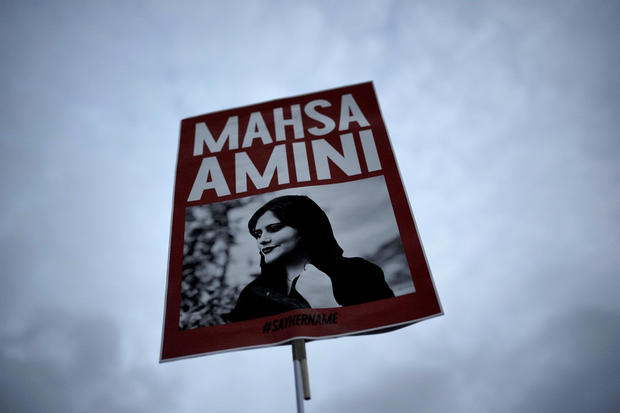Protests continue in Iran amid lethal crackdown by security forces
Fresh anti-government protests erupted across Iran on Wednesday, with images of many protests appearing on social media despite severe internet restrictions. The demonstrators appeared to be defiantly heeding a call for a day of nationwide rallies in response to a lethal crackdown by Iran's security forces in the cities of Sanandaj and Zahedan.
Also Wednesday, the Norway-based Iran Human Rights group updated its estimate of the number of protesters who have been killed by Iranian authorities during more than three weeks of almost unprecedented unrest to 201. The group said 23 of the victims were children.
The government had previously acknowledged only about 40 deaths, and claimed members of the security forces were among those killed.
The crowds who came out to demonstrate on Wednesday appeared to include a wide range of ages. Some marched and chanted "Freedom!" while some women flung their mandatory headscarves in the air.
The Center for Human Rights in Iran said that lawyers in Tehran who rallied in front of the Iran Central Bar Association were later attacked by security forces using tear gas to disperse them. At least three lawyers were arrested, the group said, adding that an eyewitness said two white vans arrested about two dozen people.
Sanandaj is the capital of the western province of Kurdistan, where residents and human rights groups have accused security forces of throwing tear gas and indiscriminately firing live ammunition into homes and at protesters at close range.
Medical professionals inside and outside of Iran have also told CBS News that since the demonstrations began on September 16, many injured protesters have either been turned away by state-run hospitals or detained when they tried to seek treatment.
Ursula von der Leyen, the president of the European Commission, condemned the "shocking violence" and called for sanctions on "those responsible for this repression."
Anger toward the regime has been particularly intense in Iran's Kurdish regions. Mahsa Amini, whose death in the custody of Iran's "morality police" sparked the protests last month, was from Saqqez, a city in Kurdistan province.
On Tuesday, the Kurdish rights group Hengaw reported that at least 5 civilians were killed and more than 400 were injured in violence inflicted by government forces over the previous three days.
In Zahedan, in the southeast Iranian province of Sistan-Baluchestan, security forces killed at least 90 people during recent demonstrations, according to Iran Human Rights.
The Islamic regime's heavy Internet restrictions makes it difficult to get a clear understanding of what's happening on the ground in Sanandaj and elsewhere in Iran. The advocacy group Netblocks reported what it calls a "major disruption" to internet traffic in Iran from Wednesday morning, dropping to around 25% compared to its peak.
Both Kurdistan and Sistan-Baluchestan provinces are home to ethnic and religious minorities, which have long been marginalized and have a history of pushing for more rights and recognition.
They are also located far from the capital of Tehran – one reason that the authorities are more willing to use force there, especially in recent days, residents told CBS News.
Across the country, human rights' groups say hundreds of children have been detained, mostly in prisons for adults. The Tehran-based Children's Rights Protection Society reported that families are being kept in the dark about their children's whereabouts and that they are not getting access to lawyers.
Iran's Education Minister Yousof Nouri acknowledged that schoolchildren have been arrested during the protests, according to Iran's Shargh daily on Tuesday. He declined to offer the number of those arrested, the newspaper reported, and said the detained students are being held in "psychological centers" – not prisons.
Once they have been "reformed," they will be allowed back to school, he added.
On Wednesday, Iran's Supreme Leader Ayatollah Ali Khamenei repeated his claim that his country's enemies are to blame for fomenting the rallies – though he dismissed them as "scattered riots" and an amateurish plot, according to the semi-official Tasnim News Agency.
Omid Memarian, an Iranian-American journalist and activist, pushed back against the claim that the riots were fueled by an external power.
"The nationwide support of the protests in Sanandaj and Sistan and Baluchestan is the best indication that people in Iran, whether from minority groups or the capital, all see themselves as united against the Islamic Republic," Memarian said. "The Iranian government usually labels any organic protests as separatist or supported by the U.S. or Israel, but this trick does not intimidate people anymore."
"The fact is that Iranians suffer from the abusive and authoritarian rule of the regime, whether they live in Tehran or the provinces," he added.
